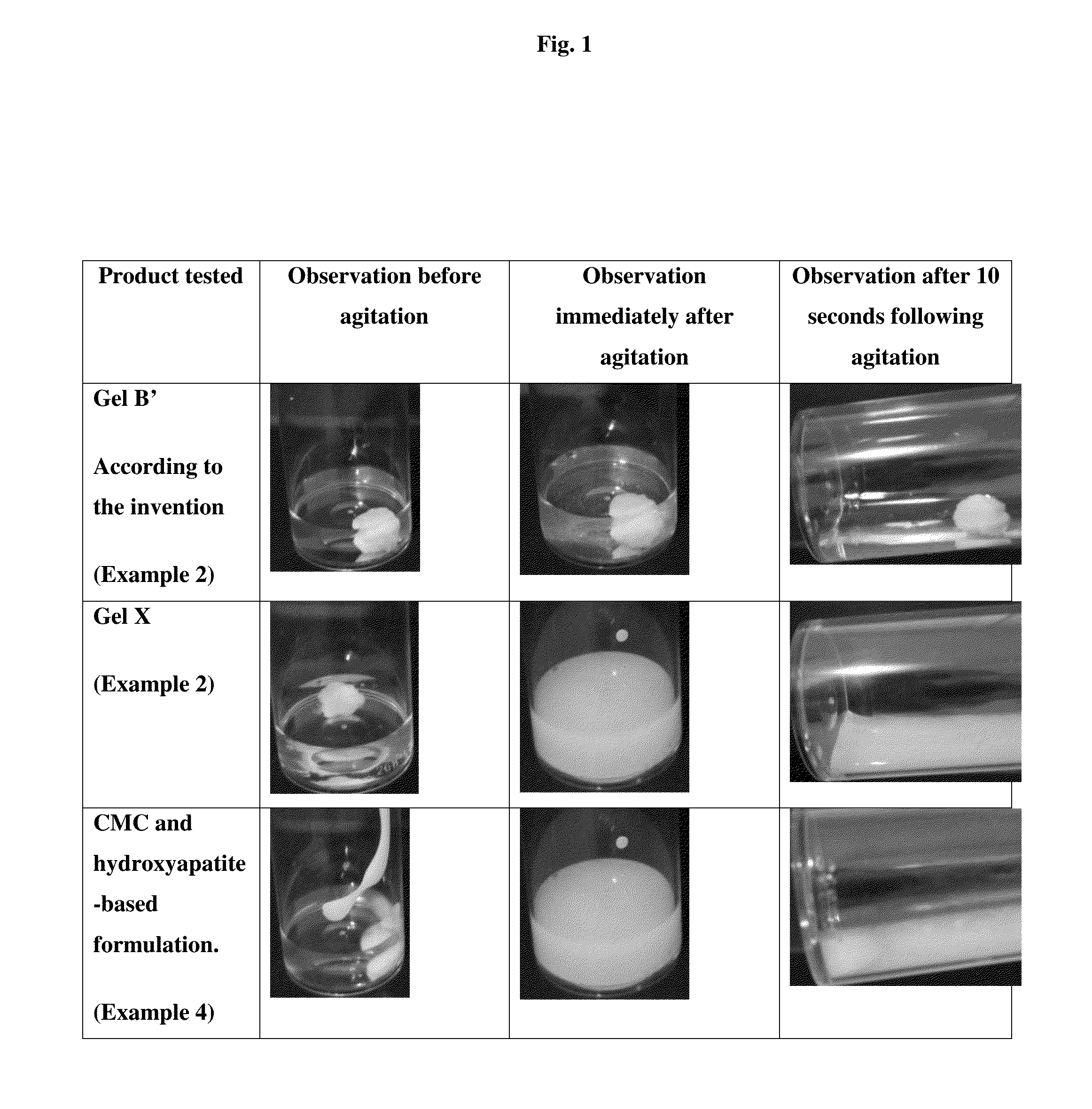Injectable sterile aqueous formulation based on crosslinked hyaluronic acid and on hydroxyapatite, for therapeutic use
a technology of hyaluronic acid and hydroxyapatite, which is applied in the field of absorbable sterile injectable aqueous formulation, can solve the problems of more or less severe complications, side effects, and product performance loss, and achieve outstanding mechanical properties and easy administration.
- Summary
- Abstract
- Description
- Claims
- Application Information
AI Technical Summary
Benefits of technology
Problems solved by technology
Method used
Image
Examples
example 1
Preparation of a Cross-Linked Hyaluronic Acid-Based Gel with a so-Called Cohesive Structure
[0087]Stage 1:
[0088]3.5 g of sodium hyaluronate with a molecular weight of 2.6 MDa was added to 1% sodium hydroxide (30.5 g). The mixture was allowed to homogenize for 1 hr 30 min. 420 mg butanediol diglycidyl ether (BDDE) was added to the homogenized mixture, sealed and placed in a water bath at 50° C. for 2 hours. The mixture was then neutralized by adding 7.5 g of 1N HCl.
[0089]The gel was purified by dialysis for 24 hours with an iso-osmolar saline solution that had a neutral pH (regenerated cellulose, separation limit: molecular weight=60 kDa) to obtain a hyaluronic acid concentration of 25 mg / ml (2.5%). It was then homogenized in a conventional paddle mixer for 1 hr 30 min (=gel A1 / 124 g).
[0090]The gel could then be degassed, packed into 2 ml glass syringes, and sterilized by steam autoclaving at 130° C. for 3 minutes (=gel A / viscoelastic gel having a so-called cohesive or monophasic stru...
example 2
Importance of the so-Called Cohesive Cross-Linked HA-Based Gel Structure
Comparison
[0103]Gel A1 (with a so-called cohesive or monophasic structure), as described in Example 1, was dialyzed with an iso-osmolar saline solution that had a neutral pH (regenerated cellulose, separation limit: molecular weight=60 kDa) to obtain a hyaluronic acid concentration of 20 mg / ml (2%).
[0104]Calcium hydroxyapatite was then added to the gel to obtain a concentration of 200 mg / ml (20%), after which mixing was carried out using a spatula (2 minutes per 5 g of gel).
[0105]The resulting gel was then sterilized in an autoclave at 121° C. for 20 minutes (=gel B′ according to the invention).
[0106]The commercial cross-linked hyaluronic acid-based gel Restylane® Perlane® (lot 11363-1) having a so-called biphasic or non-cohesive structure, and whose hyaluronic acid concentration was 20 mg / ml (2%). was enriched with 200 mg / ml (20%) of calcium hydroxyapatite by mixing with a spatula (2 minutes per 5 g of gel).
[01...
example 3
Importance of the Viscoelasticity of the Gel in Accordance with the Invention
PUM
| Property | Measurement | Unit |
|---|---|---|
| size | aaaaa | aaaaa |
| frequency | aaaaa | aaaaa |
| Tan δ | aaaaa | aaaaa |
Abstract
Description
Claims
Application Information
 Login to View More
Login to View More - R&D
- Intellectual Property
- Life Sciences
- Materials
- Tech Scout
- Unparalleled Data Quality
- Higher Quality Content
- 60% Fewer Hallucinations
Browse by: Latest US Patents, China's latest patents, Technical Efficacy Thesaurus, Application Domain, Technology Topic, Popular Technical Reports.
© 2025 PatSnap. All rights reserved.Legal|Privacy policy|Modern Slavery Act Transparency Statement|Sitemap|About US| Contact US: help@patsnap.com

